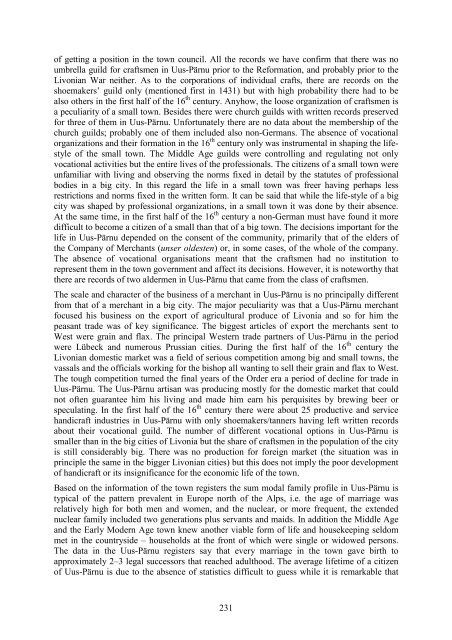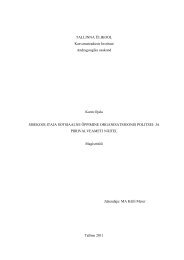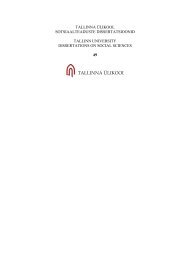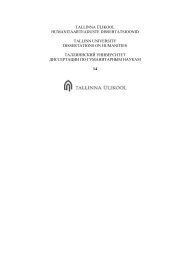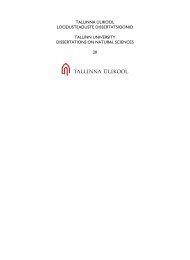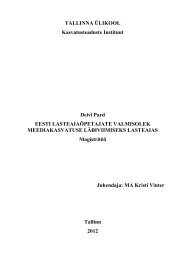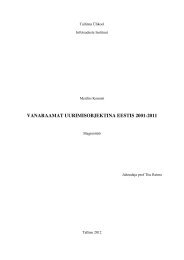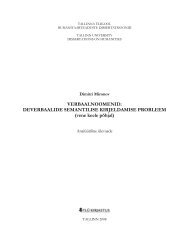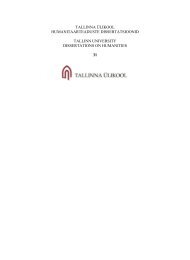You also want an ePaper? Increase the reach of your titles
YUMPU automatically turns print PDFs into web optimized ePapers that Google loves.
of getting a position in the town council. All the records we have confirm that there was noumbrella guild for craftsmen in Uus-Pärnu prior to the Reformation, and probably prior to theLivonian War neither. As to the corporations of individual crafts, there are records on theshoemakers’ guild only (mentioned first in 1431) but with high probability there had to bealso others in the first half of the 16 th century. Anyhow, the loose organization of craftsmen isa peculiarity of a small town. Besides there were church guilds with written records preservedfor three of them in Uus-Pärnu. Unfortunately there are no data about the membership of thechurch guilds; probably one of them included also non-Germans. The absence of vocationalorganizations and their formation in the 16 th century only was instrumental in shaping the lifestyleof the small town. The Middle Age guilds were controlling and regulating not onlyvocational activities but the entire lives of the professionals. The citizens of a small town wereunfamiliar with living and observing the norms fixed in detail by the statutes of professionalbodies in a big city. In this regard the life in a small town was freer having perhaps lessrestrictions and norms fixed in the written form. It can be said that while the life-style of a bigcity was shaped by professional organizations, in a small town it was done by their absence.At the same time, in the first half of the 16 th century a non-German must have found it moredifficult to become a citizen of a small than that of a big town. The decisions important for thelife in Uus-Pärnu depended on the consent of the community, primarily that of the elders ofthe Company of Merchants (unser oldesten) or, in some cases, of the whole of the company.The absence of vocational organisations meant that the craftsmen had no institution torepresent them in the town government and affect its decisions. However, it is noteworthy thatthere are records of two aldermen in Uus-Pärnu that came from the class of craftsmen.The scale and character of the business of a merchant in Uus-Pärnu is no principally differentfrom that of a merchant in a big city. The major peculiarity was that a Uus-Pärnu merchantfocused his business on the export of agricultural produce of Livonia and so for him thepeasant trade was of key significance. The biggest articles of export the merchants sent toWest were grain and flax. The principal Western trade partners of Uus-Pärnu in the periodwere Lübeck and numerous Prussian cities. During the first half of the 16 th century theLivonian domestic market was a field of serious competition among big and small towns, thevassals and the officials working for the bishop all wanting to sell their grain and flax to West.The tough competition turned the final years of the Order era a period of decline for trade inUus-Pärnu. The Uus-Pärnu artisan was producing mostly for the domestic market that couldnot often guarantee him his living and made him earn his perquisites by brewing beer orspeculating. In the first half of the 16 th century there were about 25 productive and servicehandicraft industries in Uus-Pärnu with only shoemakers/tanners having left written recordsabout their vocational guild. The number of different vocational options in Uus-Pärnu issmaller than in the big cities of Livonia but the share of craftsmen in the population of the cityis still considerably big. There was no production for foreign market (the situation was inprinciple the same in the bigger Livonian cities) but this does not imply the poor developmentof handicraft or its insignificance for the economic life of the town.Based on the information of the town registers the sum modal family profile in Uus-Pärnu istypical of the pattern prevalent in Europe north of the Alps, i.e. the age of marriage wasrelatively high for both men and women, and the nuclear, or more frequent, the extendednuclear family included two generations plus servants and maids. In addition the Middle Ageand the Early Modern Age town knew another viable form of life and housekeeping seldommet in the countryside – households at the front of which were single or widowed persons.The data in the Uus-Pärnu registers say that every marriage in the town gave birth toapproximately 2–3 legal successors that reached adulthood. The average lifetime of a citizenof Uus-Pärnu is due to the absence of statistics difficult to guess while it is remarkable that231


